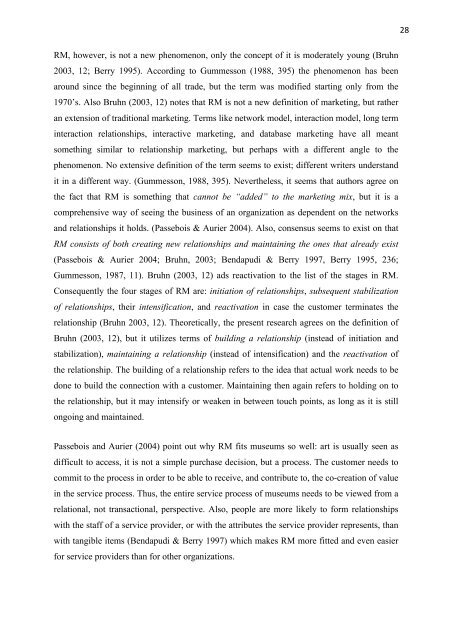Is there more to it than posting a status update?
Is there more to it than posting a status update?
Is there more to it than posting a status update?
You also want an ePaper? Increase the reach of your titles
YUMPU automatically turns print PDFs into web optimized ePapers that Google loves.
RM, however, is not a new phenomenon, only the concept of <strong>it</strong> is moderately young (Bruhn<br />
2003, 12; Berry 1995). According <strong>to</strong> Gummesson (1988, 395) the phenomenon has been<br />
around since the beginning of all trade, but the term was modified starting only from the<br />
1970’s. Also Bruhn (2003, 12) notes that RM is not a new defin<strong>it</strong>ion of marketing, but rather<br />
an extension of trad<strong>it</strong>ional marketing. Terms like network model, interaction model, long term<br />
interaction relationships, interactive marketing, and database marketing have all meant<br />
something similar <strong>to</strong> relationship marketing, but perhaps w<strong>it</strong>h a different angle <strong>to</strong> the<br />
phenomenon. No extensive defin<strong>it</strong>ion of the term seems <strong>to</strong> exist; different wr<strong>it</strong>ers understand<br />
<strong>it</strong> in a different way. (Gummesson, 1988, 395). Nevertheless, <strong>it</strong> seems that authors agree on<br />
the fact that RM is something that cannot be “added” <strong>to</strong> the marketing mix, but <strong>it</strong> is a<br />
comprehensive way of seeing the business of an organization as dependent on the networks<br />
and relationships <strong>it</strong> holds. (Passebois & Aurier 2004). Also, consensus seems <strong>to</strong> exist on that<br />
RM consists of both creating new relationships and maintaining the ones that already exist<br />
(Passebois & Aurier 2004; Bruhn, 2003; Bendapudi & Berry 1997, Berry 1995, 236;<br />
Gummesson, 1987, 11). Bruhn (2003, 12) ads reactivation <strong>to</strong> the list of the stages in RM.<br />
Consequently the four stages of RM are: in<strong>it</strong>iation of relationships, subsequent stabilization<br />
of relationships, their intensification, and reactivation in case the cus<strong>to</strong>mer terminates the<br />
relationship (Bruhn 2003, 12). Theoretically, the present research agrees on the defin<strong>it</strong>ion of<br />
Bruhn (2003, 12), but <strong>it</strong> utilizes terms of building a relationship (instead of in<strong>it</strong>iation and<br />
stabilization), maintaining a relationship (instead of intensification) and the reactivation of<br />
the relationship. The building of a relationship refers <strong>to</strong> the idea that actual work needs <strong>to</strong> be<br />
done <strong>to</strong> build the connection w<strong>it</strong>h a cus<strong>to</strong>mer. Maintaining then again refers <strong>to</strong> holding on <strong>to</strong><br />
the relationship, but <strong>it</strong> may intensify or weaken in between <strong>to</strong>uch points, as long as <strong>it</strong> is still<br />
ongoing and maintained.<br />
Passebois and Aurier (2004) point out why RM f<strong>it</strong>s museums so well: art is usually seen as<br />
difficult <strong>to</strong> access, <strong>it</strong> is not a simple purchase decision, but a process. The cus<strong>to</strong>mer needs <strong>to</strong><br />
comm<strong>it</strong> <strong>to</strong> the process in order <strong>to</strong> be able <strong>to</strong> receive, and contribute <strong>to</strong>, the co-creation of value<br />
in the service process. Thus, the entire service process of museums needs <strong>to</strong> be viewed from a<br />
relational, not transactional, perspective. Also, people are <strong>more</strong> likely <strong>to</strong> form relationships<br />
w<strong>it</strong>h the staff of a service provider, or w<strong>it</strong>h the attributes the service provider represents, <strong>than</strong><br />
w<strong>it</strong>h tangible <strong>it</strong>ems (Bendapudi & Berry 1997) which makes RM <strong>more</strong> f<strong>it</strong>ted and even easier<br />
for service providers <strong>than</strong> for other organizations.<br />
28















